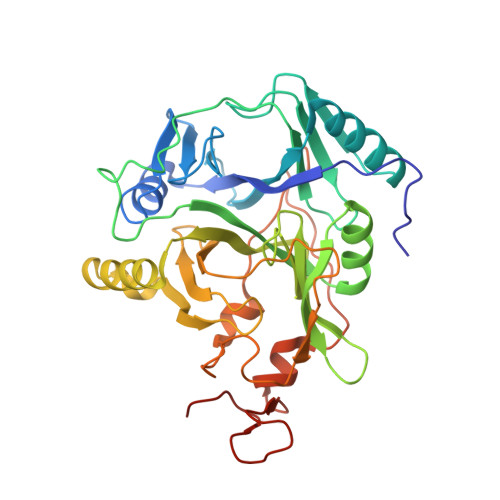Structural basis for the role of tyrosine 257 of homoprotocatechuate 2,3-dioxygenase in substrate and oxygen activation.
Kovaleva, E.G., Lipscomb, J.D.(2012) Biochemistry 51: 8755-8763
- PubMed: 23066739
- DOI: https://doi.org/10.1021/bi301115c
- Primary Citation of Related Structures:
4GHC, 4GHD, 4GHE, 4GHF, 4GHG, 4GHH - PubMed Abstract:
Homoprotocatechuate 2,3-dioxygenase (FeHPCD) utilizes an active site Fe(II) to activate O(2) in a reaction cycle that ultimately results in aromatic ring cleavage. Here, the roles of the conserved active site residue Tyr257 are investigated by solving the X-ray crystal structures of the Tyr257-to-Phe variant (Y257F) in complex with the substrate homoprotocatechuate (HPCA) and the alternative substrate 4-nitrocatechol (4NC). These are compared with structures of the analogous wild type enzyme complexes. In addition, the oxy intermediate of the reaction cycle of Y257F-4NC + O(2) is formed in crystallo and structurally characterized. It is shown that both substrates adopt a previously unrecognized, slightly nonplanar, strained conformation affecting the geometries of all aromatic ring carbons when bound in the FeHPCD active site. This global deviation from planarity is not observed for the Y257F variant. In the Y257F-4NC-oxy complex, the O(2) is bound side-on to the Fe(II), while the 4NC is chelated in two adjacent sites. The ring of the 4NC in this complex is planar, in contrast to the equivalent FeHPCD intermediate, which exhibits substantial local distortion of the substrate hydroxyl moiety (C2-O(-)) that is hydrogen bonded to Tyr257. We propose that Tyr257 induces the global and local distortions of the substrate ring in two different ways. First, van der Waals conflict between the Tyr257-OH substituent and the substrate C2 carbon is relieved by adopting the globally strained structure. Second, Tyr257 stabilizes the localized out-of-plane position of the C2-O(-) by forming a stronger hydrogen bond as the distortion increases. Both types of distortions favor transfer of one electron out of the substrate to form a reactive semiquinone radical. Then, the localized distortion at substrate C2 promotes formation of the key alkylperoxo intermediate of the cycle resulting from oxygen attack on the activated substrate at C2, which becomes sp(3) hybridized. The inability of Y257F to promote the distorted substrate structure may explain the observed 100-fold decrease in the rates of the O(2) activation and insertion steps of the reaction.
Organizational Affiliation:
Institute of Molecular and Cellular Biology, University of Leeds, Leeds, LS2 9JT, UK. E.G.Kovaleva@leeds.ac.uk





















